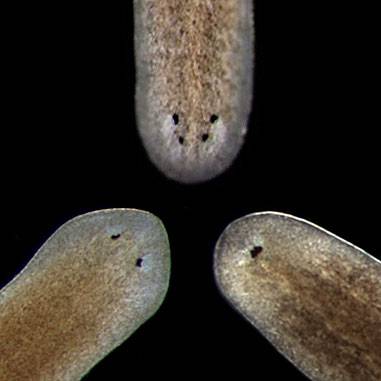Gene that controls regeneration of head and brain discovered
4 May 2010
Biologists at The University of Nottingham have discovered the gene that enables the planarian worm to regenerate its whole head and brain.
The discovery could point to ways to regenerate old or damaged human organs and tissues.
The research led by Dr Aziz Aboobaker, a Research Councils UK Fellow in the School of Biology shows for the first time that a gene called 'Smed-prep' is essential for correctly regenerating a head and brain in planarian worms. The study has been published in the open access journal PLoS Genetics.

Planarian worms
Planarian worms are non-parasitic flatworms from 1-20mm long that are found in saltwater, freshwater and terrestrial environments. They have an amazing ability to regenerate body parts, including a head and brain, following amputation. The worms contain adult stem cells that are constantly dividing and can become all of the missing cell types. They also have the right set of genes working to make this happen exactly as it should so that when they re-grow body parts they end up in the right place and have the correct size, shape and orientation.
Dr Aboobaker said: “These amazing worms offer us the opportunity to observe tissue regeneration in a very simple animal that can regenerate itself to a remarkable extent and does so as a matter of course.
“We want to be able to understand how adult stem cells can work collectively in any animal to form and replace damaged or missing organs and tissues. Any fundamental advances in understanding from other animals can become relevant to humans surprisingly quickly.
“If we know what is happening when tissues are regenerated under normal circumstances, we can begin to formulate how to replace damaged and diseased organs, tissues and cells in an organised and safe way following an injury caused by trauma or disease. This would be desirable for treating Alzheimer’s disease, for example. With this knowledge we can also assess the consequences of what happens when stem cells go wrong during the normal processes of renewal — for example in the blood cell system where rogue stem cells can result in Leukaemia.”
Smed-prep is necessary for the correct differentiation and location of the cells that make up a planarian worm’s head. It is also sufficient for defining where the head should be located on the worm. The team have found that although the presence of Smed-prep is vital so that the head and brain are in the right place, the worm stem cells can still be persuaded to form brain cells as a result of the action of other unrelated genes. But even so, without Smed-prep these cells do not organise themselves to form a normal brain.
Daniel Felix, a graduate student who carried out the experimental work said: “The understanding of the molecular basis for tissue remodelling and regeneration is of vital importance for regenerative medicine. Planarians are famous for their immense power of regeneration, being able to regenerate a new head after decapitation. With the homeobox gene Smed-prep, we have characterised the first gene necessary for correct anterior fate and patterning during regeneration.”